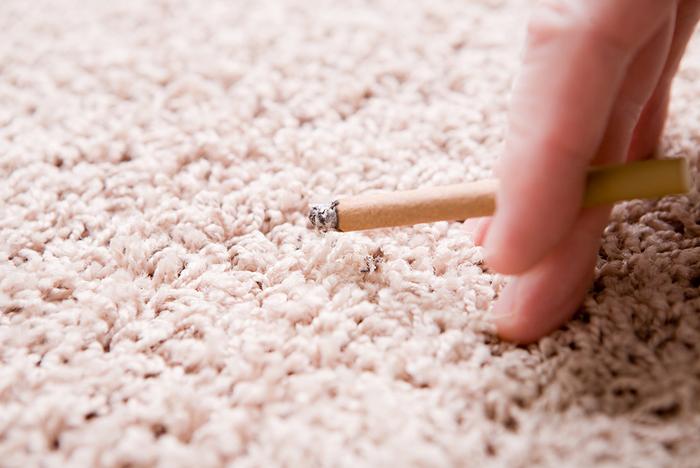– By Christina Nunez

Credit: Bryngelzon/iStock
– By Christina Nunez
In rooms where smoking has taken place regularly, tobacco’s imprint lingers on indoor surfaces, even long after regular smoking has stopped. The leftover residues, known as thirdhand smoke, can be a long-term source of indoor pollutants. New research from a team led by the Department of Energy’s Lawrence Berkeley National Laboratory (Berkeley Lab) zeroes in on carpets as an especially potent – and difficult to clean – reservoir of tobacco contaminants.
When thirdhand smoke settles into surfaces, it doesn’t stay there. Chemicals re-enter the air, sometimes transforming into new types of contaminants. Carpet is a major sink for thirdhand smoke. In this study, the researchers evaluated the effects of ozonation, a common cleaning method, on smoke-exposed carpet.
The study, which was recently published in the journal Environmental Science and Technology, examined smoke-contaminated aged carpets that had been retrieved from homes in the San Diego area, as well as new carpet exposed to fresh smoke in the lab.
The team found that while ozonation partially removed a group of compounds named polycyclic aromatic hydrocarbons from both aged and fresh carpet samples, it was relatively ineffective at removing deeply embedded nicotine, because the fibers and other chemical constituents in the material serve as a chemical shield. They evaluated the samples in a room-size environmental chamber at Berkeley Lab’s Air Quality Testing Laboratory, with additional tests carried out at the Molecular Foundry, a DOE Office of Science user facility at Berkeley Lab.
The research, which was supported by grants from the University of California Tobacco-Related Disease Research Program, highlights carpets as a common and important reservoir and source of contaminants from thirdhand smoke.
“Because it does not reach deeply into materials, ozone has a limited ability to ‘clean’ permanently,” said Berkeley Lab researcher Xiaochen Tang, the study’s lead author. “In the case of carpet, the best solution may be replacing it with a new one.”
The work builds on a previous study from Berkeley Lab’s Indoor Environment Group, which found that ozonation could remove tobacco contaminants from a room. In that 2021 study, the ozonation was conducted only on freshly generated thirdhand smoke.
Ozone generators release ozone gas so that it can react with harmful compounds and remove them from the air and from surfaces. But the generator also creates a burst of contaminants when running, the previous study showed, pointing to the need for ventilation and a waiting period before people can re-enter a space after ozonation.
Berkeley Lab Senior Scientist Hugo Destaillats noted that ozonation has been used as a remediation method for years because it is good at removing odors – but that can create a false sense of efficacy.
“Ozone generators are also used to remediate fire damage and mold, but they have limitations, as we saw in this study,” Destaillats said. “The lack of a detectable smell does not mean that all of the contaminants we are concerned about have been eliminated.” Next steps in this research will evaluate the role of other indoor reservoirs, such as drywall and upholstery.
###
Founded in 1931 on the belief that the biggest scientific challenges are best addressed by teams, Lawrence Berkeley National Laboratory and its scientists have been recognized with 16 Nobel Prizes. Today, Berkeley Lab researchers develop sustainable energy and environmental solutions, create useful new materials, advance the frontiers of computing, and probe the mysteries of life, matter, and the universe. Scientists from around the world rely on the Lab’s facilities for their own discovery science. Berkeley Lab is a multiprogram national laboratory, managed by the University of California for the U.S. Department of Energy’s Office of Science.
DOE’s Office of Science is the single largest supporter of basic research in the physical sciences in the United States, and is working to address some of the most pressing challenges of our time. For more information, please visit energy.gov/science.
Journal
Environmental Science & Technology
DOI
10.1021/acs.est.3c01628
Article Title
Remediation of Thirdhand Tobacco Smoke with Ozone: Probing Deep Reservoirs in Carpets
Article Publication Date
27-Jun-2023




